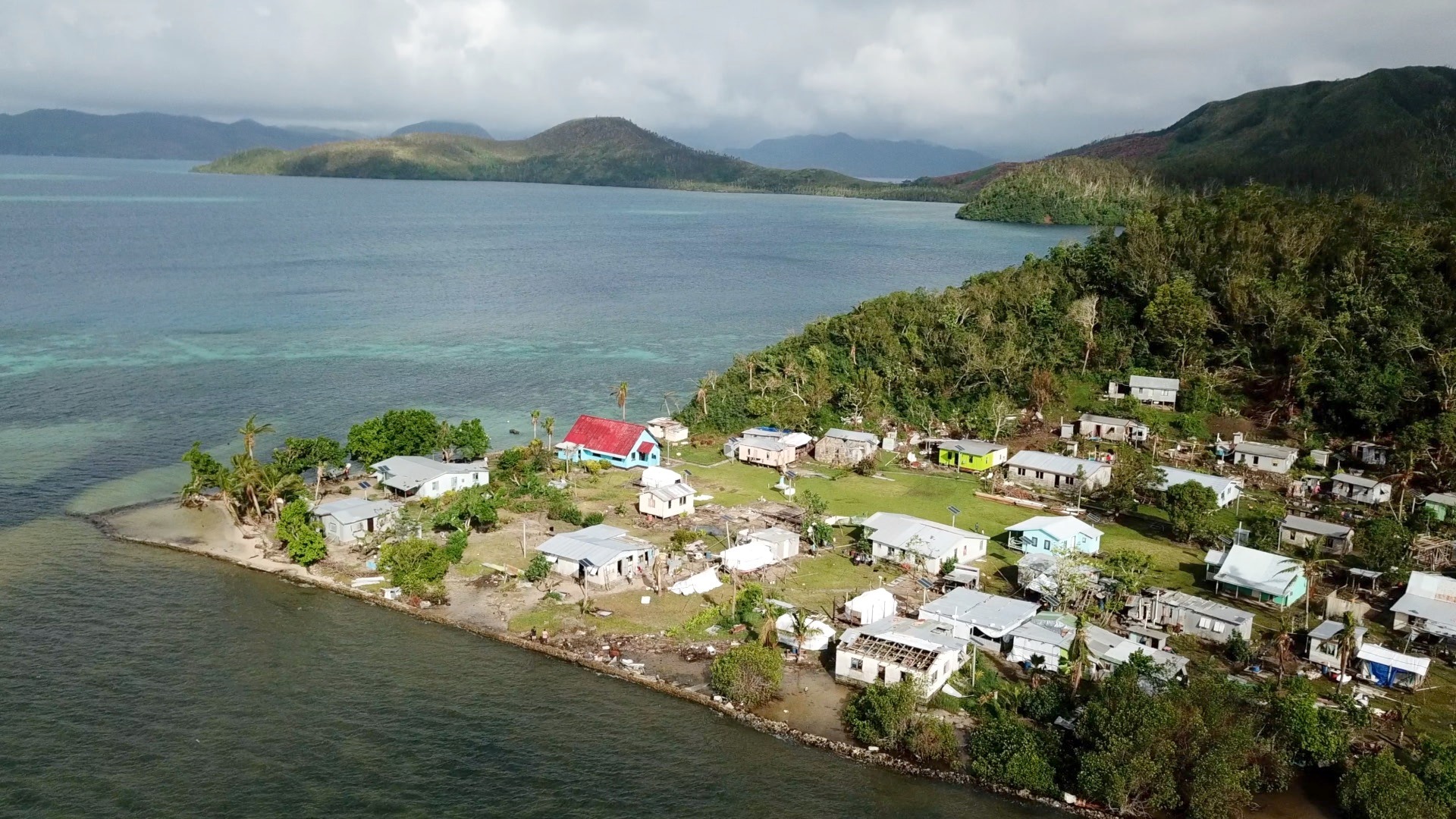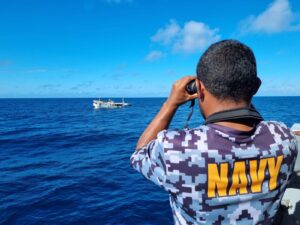Eight years ago the villagers of Narikoso, a coastal village on Ono Island, Kadavu in Fiji, were promised relocation, away from rising sea levels that threatened their livelihoods and future existence.
The Fijian government and international agencies mobilised resources to facilitate relocation in June 2011. However, proper processes were not followed in the initial stages, setting off a cascade of events that have worsened the villagers’ plight. To this day, the villagers of Narikoso are still waiting to be relocated.
Talks begin
Narikoso is one of seven villages on Ono Island, and the only one reportedly facing severe coastal erosion. It is also one of around 40 villages the Fijian Government has identified as prone to environmental disasters and climate change and in need of relocation to higher ground.
The Kadavu island chain that Ono is a part of sits approximately 85 kilometers away from Fiji’s capital city, Suva. The villagers of Narikoso, which is accessible only by boat, depend on subsistence agriculture and the sea for their livelihoods, both of which were threatened by the rushed relocation attempt.
Action stemming from the decision to relocate, such as the clearing of mangroves and excavation work, led to further environmental damage, while the relocation agencies’ decision to reduce the number of households in need of relocation from 27 to seven left some villagers hesitant to move.
Villager Kelepi Saukitoga, who was one of those actively involved in the initial rounds of discussion with government, said the villagers first offered alternatives to relocation.
They suggested either constructing a new seawall or strengthening an existing seawall to mitigate the impacts of sea-level rise and coastal erosion, he said. The suggestion was based on their experience of how an existing seawall built in the early 1970s provided some solace from the rising seas.
“But, the [prime minister] told us that it would be better to move the village rather than build a seawall,” Saukitoga said.
Village chief Bulou Katarina Rarasea said the villagers reached a consensus “to move everyone, comprising 27 households, the two churches and the health centre, to higher ground.”
A year later, in 2012, the national government mobilised military engineers to clear and level the land for the proposed new village site. In doing so, villagers claim that the Fijian military removed the mangroves that lined the village shoreline to get equipment onto the island before excavating and using dynamite to level the new village site.
Landowners who had offered their land for relocation were not happy about the way in which the initial work was carried out, claiming that they were not involved as much as they would have liked.
“Two landowner units sat and agreed to provide the land for the new village site. But when it was time to consult about the new village location, the government only spoke with the village headman,” said villager Semesa Matanawa.
“We thought they would start their excavation from atop the hill, because it would then allow us a view that overlooks both sides of the island.
Instead they started excavation work from the foot of the hill,” he added.
Lasting impact
The destruction of mangroves and trees along the shoreline, the excavation and dynamiting of the mountaintops and the resulting sediment that flowed out to sea damaged the coastal reefs on which the villagers’ livelihoods depended, Bulou Katarina said.
Subsequent attempts by the government to mitigate the damage, stemming from the Mineral Resources Department’s (MRD) assessment that the new site was unstable, are well documented in earlier accounts of Narikoso villagers’ relocation experience. Saukitoga said MRD officers advised them that the site needed to be stabilised first before they could move.
“The officials planted vetiver grass, fruit trees and other forest trees atop the cleared site to stabilise the soil,” he said.
Mangrove seedlings were planted along the shoreline where soldiers had cut the trees to provide some buffer against waves and erosion and reinstate an integral source of food for the villagers. Many of them catch fish, crabs and bivalve from surrounding mangrove areas, without having to pay for fuel to venture further out to sea.
However, the damage had been done.
“When the clearing works commenced, there was a lot of soil erosion and we couldn’t gather seafood like we used to. The government came and carried out their work. They excavated the land, but it was not carried out in the way we wanted,” Bulou Katarina said.
Matanawa said the military only liaised with the village headman, and in doing so missed out on the opportunity to scout out other locations that could have accommodated the whole village and been easier to excavate.
In 2015, an economist sent to Narikoso to carry out a cost-benefit analysis at the request of the Fijian Government’s Climate Change Division (CCD) deduced that the relocation of the whole village would be uneconomical for the government, because only 10 households were located in the red zone – or the zone most affected by high tides and rising sea levels.
According to the analysis, it appeared the authorities had jumped the gun on some key requirements that were needed before relocation actions could commence on the ground.
The analysis also attributed the failed relocation attempt to a lack of money devoted to the project and not enough discussion about community-based adaptation options.
It called on the Fijian Government to ensure they adopted relocation guidelines and to allow for relocation only when it is the most efficient solution.
A new approach
The German Development Agency (GIZ) then put forward a new proposal to move only some of the houses in the red zone.
“In our first discussion with GIZ, we were told that only 17 houses would be relocated. Later on, they said only seven households would move and they have maintained the number to date,” Matanawa said.
Yet villagers were unreceptive to the change in tune, particularly the idea of breaking up the village.
“We should all move as one village. Whichever side the waves come from, it is only right that we move as one tribe of ‘Raviravi’,” Bulou Katarina said.
“If this partial relocation takes place, it would mean breaking up and dividing the village, because only one clan will relocate while the rest of us stay,” Matanawa noted.
In response to questions from Mai TV, GIZ sent a background document about the project and said more information, such as lessons learnt, would be made available as it neared its expected completion of the project later in the year.
Lessons learned
Sea level rise isn’t the only concern for the villagers of Narikoso.
The village, like other low-lying communities in Fiji, is vulnerable to tropical cyclones that have been predicted to increase in intensity in the future.
In February 2016, Tropical Cyclone Winston, deemed the most powerful tropical cyclone to ever hit the country, killed 44 people and caused more than $1bn worth of damage. Kadavu was one of the hardest hit areas. Four years later, Tropical Cyclone Harold exposed Narikoso’s relocation flaws when winds from the Category 4 storm damaged partly built houses on the site that was intended for the seven red zone households.
Government officials and agencies tasked with overseeing relocation efforts have since drawn on the experience of trying to relocate Narikoso to guide subsequent coastal degradation adaptation strategies.
In 2018, the government published official relocation guidelines that outline how to undertake climate change-related relocation. The framework comprises three stages: the pre-relocation stage; relocation stage and post-relocation stage.
It states that in the pre-relocation stage the government must ensure a comprehensive and inclusive planning process, mechanisms must be put in place to ensure transparency and accountability together with a clear timetable and budget.
Studies such as “Relocation as an Adaptation to Sea-Level Rise: Valuable Lessons from the Narikoso Village Relocation Project in Fiji” by researcher Amanda Bertana highlight the importance of the Narikoso case, since village relocations will become more prevalent in Fiji and the Pacific Islands as the region becomes more vulnerable to the effects of climate change.
According to Care, an international humanitarian organisation dedicated to ending poverty, 33.4 million people were displaced in 2019 worldwide, of which 70% were owing to climate-related disasters. Projections are that a further 2.1-meter rise in sea levels would displace 200 million people around the world, according to the Ecological Threat Register 2020 – which measures ecological threats that countries are currently facing – produced by Australia-based global think tank, Institute for Economics and Peace (IEP).
For now, the villagers of Narikoso are still awaiting updates from both the government and GIZ about the relocation project. Saukitoga said they have been following up with the government and GIZ, via phone calls and visits to Suva.
He and the other villagers are hoping to have a briefing and discussion about the project in the same hall where they made an agreement with the government about relocation.
The government has not responded to repeated requests for comments.
Reporting for this story was supported by the Internews Earth Journalism Network









